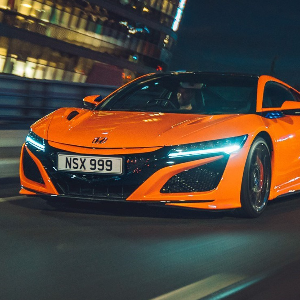
For a driving enthusiast, the merest mention of a ‘family sports utility/crossover’ is anathema. A jacked-up, mid-sized faux off roader, with dubious dynamic ability, the aerodynamics of a cart horse and less space than an equivalent estate, how was that ever a good idea?
Allow me to walk a mile in another’s shoes; the school run, the traffic jam, the shopping mall, where extras such as parking sensors trump cornering ability, extra ride height allows the easy lacing of a toddler’s shoes, and a high-mounted boot allows dog and shopping to be hurled in without a care.
Small wonder these ‘soccer-mom’ SUVs dominate the market; they are simple, straightforward transport, with a commanding view from the driver’s seat. Though, manufacturers’ long development cycles and a tendency for car makers to plagiarize each other’s model plans, also go some way to explain why the SUV/crossover body style occupies almost half the entire car market.
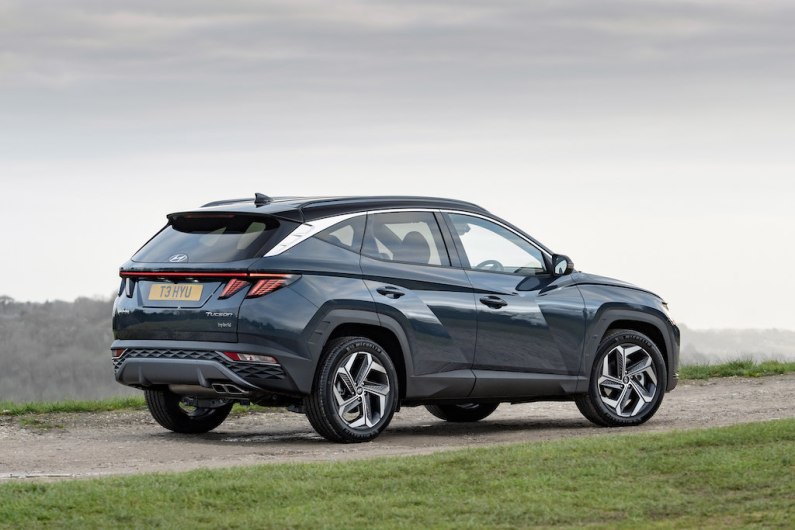
Yet there’s more that unites than divides here. The average SUV/crossover buyer might not prize dynamics above all else, but as Ford proved first with the 1993 Mondeo and then the 1998 Focus, ordinary folk like taut handling and steering feedback as much as anyone else, and who doesn’t love a car which starts every morning, holds on to its value and comes with a keen price?
In the UK, the queen of middling SUVs is Nissan’s Qashqai, which leads a big pack, with Volkswagen’s Tiguan, Kia’s Sportage and Niro and Ford’s Kuga following on. Hyundai’s Tucson has stooged around the sixth and seventh position, despite its buyer-friendly, five-year unlimited-mileage warranty and family-friendly space.
Tucson was considered dull and that’s a ball and chain in this market where no one needs reminding that they’re driving a non-premium family charabanc - witness the almost total collapse of the Multi-Purpose Vehicle (MPV), market in the early part of this century.
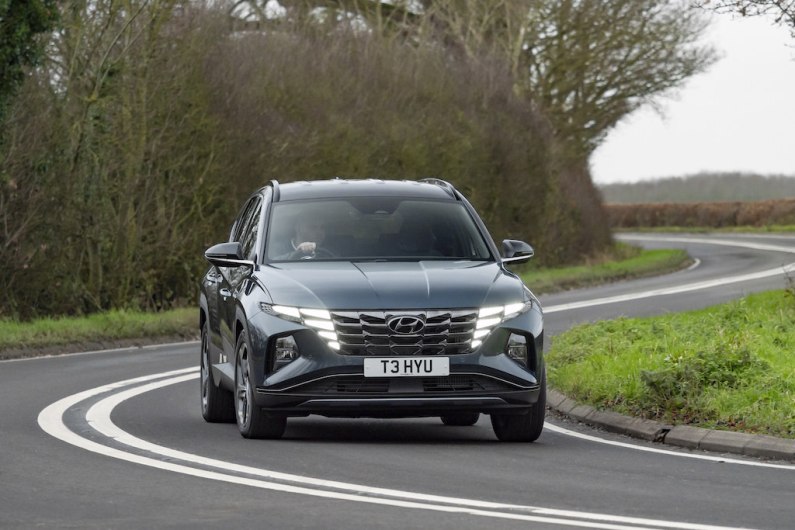
Yet as a flurry of snow heralded my drive of the new Mark-IV Tucson, what are these SUV crossovers if not a tougher looking MPV? After all, most of them drive just the front wheels, most have huge wheels and tyres and almost none of them come with a set of crawler gears. Snow is a great leveler in the crossover market where the phrase ‘all hat and no cattle’ hovers in the back of the mind.
We could ponder the ins and outs of SUV versus MPV until those cows come home and put their feet up, but Hyundai is firmly in this market whatever it is. With sales of over seven million over 16 years and three generations (1.4 million of them in Europe), the Tucson is Hyundai’s best-selling model, though the second-generation version (2009 – 2015) was called the ix35.
So, the Mark IV is a big deal and under the guidance of SangYup Lee, head of Hyundai's global design centre, Tucson has been given a comprehensive makeover. His plan is that from now on, each of Hyundai’s SUV models will carry their own separate identity and design.
Tucson is built in plants around the world on two different wheelbases and lengths, though the European model, which is made at the company’s factory in the Czech Republic, is based on the short wheelbase (2,680mm), which means that an overall 4,500mm in length, it’s a wee bit bigger all round than the outgoing model.
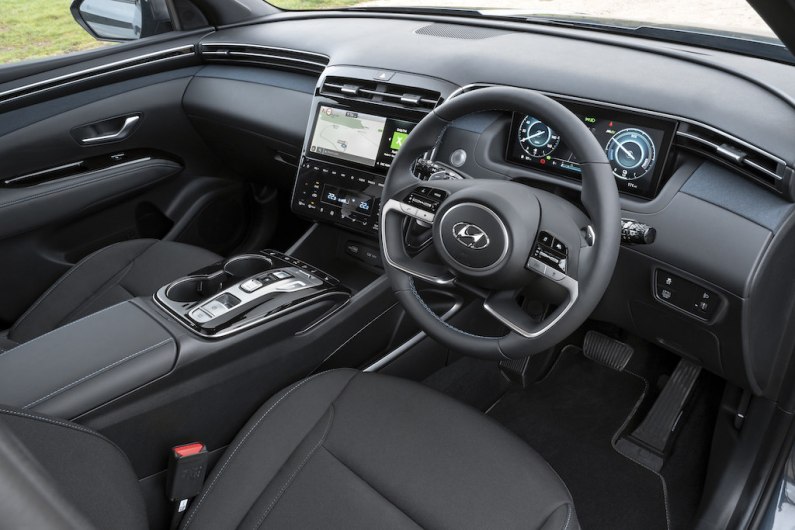
And, while it doesn’t have the beauty of this year’s Alfa Romeo Tonale, the new Tucson is sharp and handsome if a bit fussy in places. Those complicated front wings wouldn’t look out of place on a pre-WWII Voisin and the grille and headlamp clusters look like an explosion in the triangle factory. The rear is more conventional with a strip lighting arrangement across the tail gate.
On sale now, there are four powertrains available at first with a diesel and plug-in hybrid to come later this year. All the initial models are based on Hyundai’s 1.6-litre turbocharged petrol unit, with a 148bhp base model drivetrain, which comes with the option of a 48-volt mild hybrid system. There’s also a 178bhp mild-hybrid option and a full hybrid with 227bhp. Transmission choice depends on the engine, with two types of six-speed manual, a six-speed automatic and a seven-speed dual-clutch automatic unit. Four-wheel drive is an option on some models.
There are three main trim levels: SE Connect, Premium and Ultimate, with the previous base model disbanded so SE Connect comes with a pretty good specification. Standard equipment includes: leather-covered steering wheel and gear knob; dual-zone air conditioning; cruise control; heated and folding door mirrors; rear parking sensors; and a rear-view camera. Standard safety electronics consist of Forward Collision Assist, which recognises cars, pedestrians and bicycles, intelligent cruise control, with lane assistance (which can be switched off) and multi-collision prediction braking. There’s a 10.25in digital instrument panel and equally sized centre touch screen.
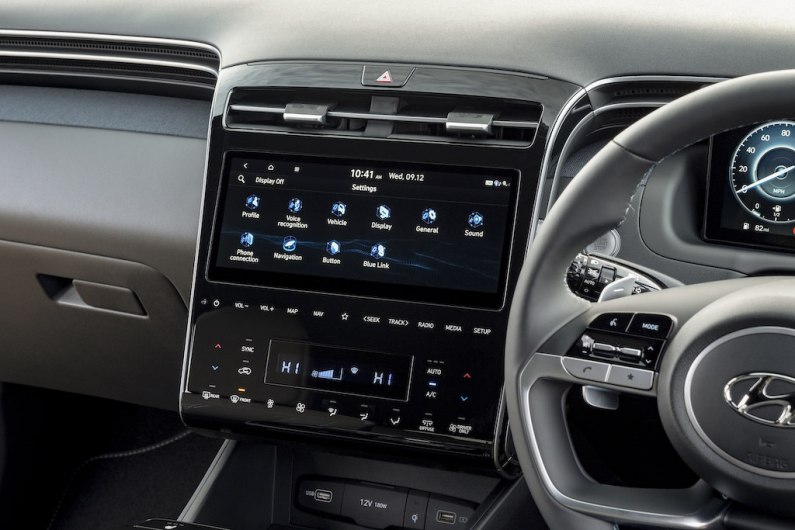
The facia is classy and well made, with large sweeps of soft-touch plastic-covered panels and clear and concise graphics for the digital screens. The style follows that of the Nexo fuel-cell model, with brushed silver finishes, a push-button gear change (for the full hybrids) and an unmistakable impression of space-age modernity. The balance of push button and touch screen controls is excellent and you don’t find yourself with your eyes away from the road too much. Particularly commendable is the separate control panel for the heating and ventilation controls.
The seats are mostly comfortable, but the raised seams can be felt through your backside and there’s not a lot of side support. The storage space round the front seats is commodious and well designed, with large door pockets and good cubby holes. The cheaper SE Connect gives you a proper ignition key, but in higher specifications there’s keyless ignition and all models have electronic hand brakes.
The rear bench has generous leg and head room and it’s wide enough for three adults to sit across. An artificially high boot floor means the 40/20/40 per cent folding seat backs give an almost flat load bed and there’s room under the boot floor for the load/luggage cover when not in use, though there’s no spare wheel. The rear-seats-up load volume of 616 litres is bigger than the Qashqai or Kuga and about the same size as the Tiguan.
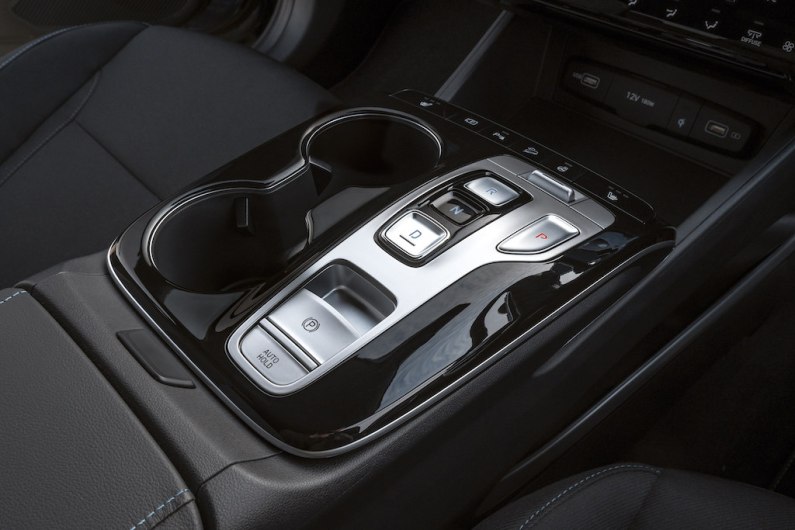
Dull but worthy sums up the dynamics of the previous three Tucsons, and Hyundai has spent time and cash to improve the car. Standard dampers have a bit more adjustment to the way they resist body movement, the steering rack now comes from a European rather than a South Korean supplier and there’ve been changes to the MacPherson strut front, multi-link independent rear suspension with electronically adjustable magnetorheological damping on the top models.
We drove the 1.6-litre turbocharged petrol hybrid in SE Connect trim – costing £32,035 it is likely to be the UK’s most popular model. On 17-inch wheels and tyres, and passive damping, it doesn’t feel much of an improvement on previous Tucson models. The steering feels inert and over assisted, with sharp thumps over potholes and bumps and a roly-poly approach to undulations. The body roll feels excessive and comes in too fast as you turn into a corner and there’s too much side-to-side body movement, which is a particular problem on British country roads with their broken edges. Oh, and it pitches under hard braking.
All of which is a shame as with 227bhp and 195lb ft to motivate just under 1.7 tonnes, the performance feels brisk with an entirely credible sub eight second 0-62mph acceleration claim. It’s almost too powerful at times, with a tendency to spin up the front wheels pulling away on wet roads and accelerating out of tight corners. Overtaking is a cinch and the drivetrain feels well engineered, refined and quiet though the engine’s pretty vocal at high revs.
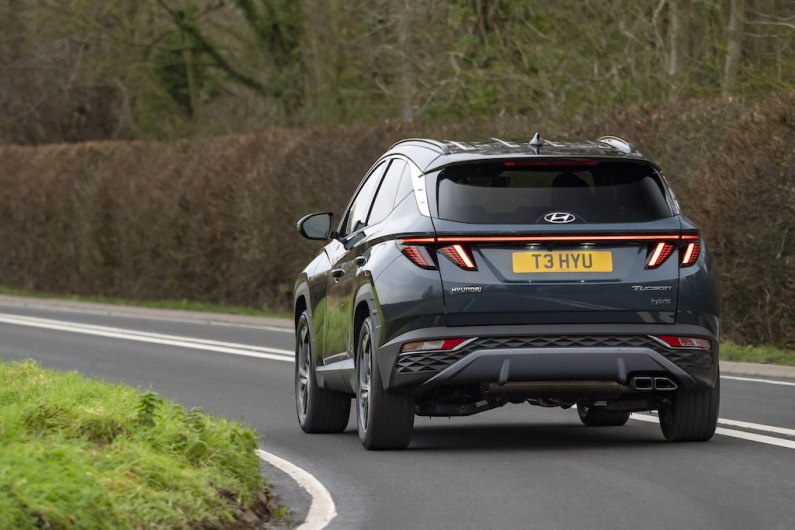
What’s more the combination of battery regeneration and friction braking is really very good. Most car makers fail to satisfactorily mix the two, but Hyundai has achieved almost seamless slowing with the Tucson.
And with a well-insulated cabin and quiet cruising, the Tucson is a good companion for long motorway journeys just so long as you don’t want to chuck it around when you get there.
We did get a quick drive in the 48-volt mild hybrid, 4x4 version on 19-inch wheels and tyres, which felt more sure footed, with a better ride quality, more communicative steering and better body control. Best of the bunch, though was the Premium car, as much for its adjustable damping as its panoramic sunroof and leather chairs. You felt the chassis trying to do all the things the standard car does, but those larger wheels and clever reactive dampers mitigating those tendencies as well as giving more positive driving experience.
If you just take the outward appearance and the much-improved cabin, this new Tucson represents good value for money, with five-year warranty peace of mind and a bit more space than the class leaders. But the £28,495 standard car in base trim isn’t much cop to drive, and if you want to improve that, you need to spend money for bigger wheels and tyres and preferably adjustable dampers, and if you add in four-wheel drive as well, you are looking at £37,380 for the Ultimate with the seven-speed twin-clutch DCT transmission and the £1,300 Tech Pack.
Nick Reilly, the shrewd former Vauxhall boss, who lived and worked in South Korea always said the Hyundai/Kia would catch up with the quality and dynamics of the European brands eventually, but said that “then the cars will cost the same as their European rivals.” He’s been proved right. I liked the Tucson, but do I like it as much as a Tiguan or a Nissan Qashqai? That decision is more obscured than ever.
2021 Hyundai Tucson Mark IV
Price: from £28,495, as tested £32,035
Engine: 1,598cc turbocharged petrol four cylinder with full hybrid system
Power/torque: total system output 227bhp @ 5,500rpm, 195lb ft @ 1,500rpm
0-62mph: 8sec
Top speed: 120mph
Fuel economy: WLTP Combined 50.4mpg, on test 45mpg
CO2 emissions: 127g/km
VED Band: £165 first year, then £140
Ends
